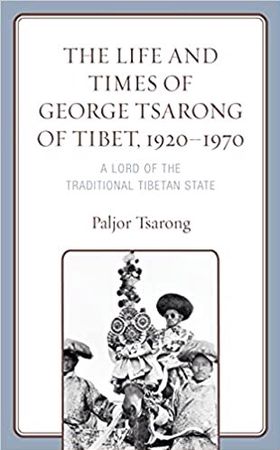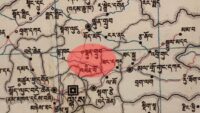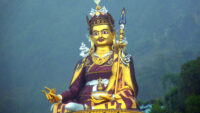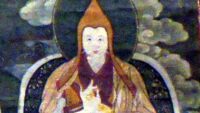རྒྱུན་སྲོལ་བོད་རྒྱལ་ཁབ་ཀྱི་མངའ་བདག་ཅིག
བསྟར་རིམ་རྩོམ་སྒྲིག་པ། གེ་རེ་ཊ་ཊལ་ (Gray Tuttle) ཀོ་ལམ་བི་ཡ་མཐོ་སློབ། (Columbia University)
རྩོམ་པ་པོ། ཚ་རོང་དཔལ་འབྱོར། རྒྱབ་ཤ་མཁྲེགས་པོ། ཕྱི་ལོ་༡༩༢༡ ཟླ་༡༢ ཚེས་༣༡ ལ།
མ་རྩའི་རིང་ལུགས་སྔོན་གྱི་ཞིང་ལས་ཀྱི་རྒྱལ་ཁབ་མང་པོ་ཞིག་ཉམས་འཇིག་ཏུ་ཕྱིན་ནས་དུས་རབས་མང་པོ་ཞིག་སོང་། ཕྱི་ལོ་ ༡༩༠༣ ལོའི་དབྱིན་ཇིའི་བཙན་འཛུལ་དང་ཕྱི་ལོ་ ༡༩༥༠ ལོ་རྒྱ་ནག་གིས་བཙན་འཛུལ་བྱས་མིན་ལ་མ་བལྟོས་པར་ཕྱི་ལོ་ ༡༩༥༩ ལོ་བར་བོད་རྒྱལ་ཁབ་ཀྱིས་མུ་མཐུད་
བསྐྱར་ཞིབ།
—མེལ་ཝིན་སི་གོལ་སི་ཊིན། ཁེ་སེ་ཝེ་སི་ཊིན་མཐོ་སློབ།
—Melvyn C. Goldstein, Case Western Reserve University
ཚ་རོང་གཟིམ་ཤག་གི་ལོ་རྒྱུས་དེ་ནི་ཕྱོགས་མང་པོ་ཞིག་གི་ཐོག་ནས་དུས་རབས་ཉི་ཤུ་པའི་ བོད་ཀྱི་ལོ་རྒྱུས་ཤིག་ཡིན། “ཚ་རོང་འཇོར་འཇིའི་སྐུ་ཚེ་དང་དུས་ཚོད་” ཀྱི་ནང་ཚ་རོང་དཔལ་འབྱོར་གྱིས་དབྱིན་ཡིག་ཐོག་ཞིབ་ཚགས་དང་མཁས་བྱང་ཆུབ་པའི་སྒོ་ནས་རྒྱལ་ཡོངས་དང་མི་སྒེར་གྱི་ལོ་རྒྱུས་མཉམ་དུ་བསྒྲིགས་ནས་འདས་པའི་དུས་རབས་ནང་གི་རྒྱུན་སྲོལ་བོད་ཀྱི་མི་དྲག་སྤྱི་ཚོགས་སྐོར་བྲིས་ཡོད། ད་དུང་བོད་གཞུང་དང་དེང་རབས་ཅན་གྱི་འཛམ་གླིང་ཞིག་འབྱུང་ཐབས་དང་རྒྱ་མིའི་དབང་སྒྱུར་མེད་པ་བཟོ་ཐབས། བཙན་བྱོལ་ནང་བོད་རྒྱལ་ཁབ་དང་སྤྱི་ཚོགས་ཤིག་བསྐྱར་འཛུགས་གནང་རྒྱུའི་སྐོར་བྲིས་ཡོད། རྩོམ་པ་པོའི་ཡབ་ལ་གཞི་རྒྱ་ཆེ་བའི་བཅར་འདྲི་ཞུས་པ་རྣམས་རྨང་གཞིར་བྱས་ནས་དུས་ཐོག་ལ་འཁེལ་བའི་དེབ་ཐེར་འདིས་མི་སྒེར་གྱི་དྲན་ཤེས་ལས་མགྱོགས་མྱུར་ཡལ་འགྲོ་བའི་རྩ་ཆེའི་དུས་ཚོད་དང་ས་གནས་སོགས་ལ་ལྟ་བའི་སྒེ་ཁུང་ཞིག་ཕྱེ་ཡོད།
—སྦེ་ནོ་ཝི་ནར། ཀར་ནེ་གེ་མེ་ལོན་མཐོ་སློབ།
—Benno Weiner, Carnegie Mellon University
ཚ་རོང་འཇོར་འཇི་(བདུད་འདུལ་རྣམ་རྒྱལ) གྱི་སྐུ་ཚེ་དེས་སྙན་གྲགས་ལྡན་པའི་རྒྱལ་ས་ལྷ་སའི་སྐུ་དྲག་གི་གཟིམ་ཤག་ཅིག་གི་ནང་འཚར་ལོངས་བྱུང་བའི་ཁྱད་དུ་འཕགས་པའི་བསྐོས་ཐང་ཞིག་མཚོན་པར་བྱས་ཡོད། ཁོང་གི་ཡབ་ཆེན་ཟླ་བཟང་དགྲ་འདུལ་ནི་དེངས་རབས་ཅན་གྱི་བོད་ཀྱི་ཐོག་ལྟེ་ཤིང་ལྟ་བུའི་འགན་ནུས་ཤིག་འདོན་པ་གནང་ཡོད་ཅིང་ཁོང་རང་ཉིད་ཤོད་དྲུང་ཞིག་ཡིན་པའི་ཆ་ནས་རྒྱུན་སྲོལ་བོད་གཞུང་གི་སྲི་ཞུ་བསྒྲུབས་པ་ནས་གུང་ཁྲན་གྱི་བཙན་འོག་བོད་ནང་ཕྱག་ལས་གནང་བ་དང་། མཐའ་མར་བཙན་བྱོལ་བོད་གཞུང་ནང་ཕྱག་ལས་གནང་ཡོད། ཁོང་གི་ཡབ་ཀྱི་རྣམ་ཐར་འབྲི་གནང་མཛད་སྐབས་ཚ་རོང་དཔལ་འབྱོར་གྱིས་བོད་ཀྱི་མི་དྲག་ལམ་ལུགས་དང་ཕྱི་ལོ་༡༩༥༩ གོང་གི་བོད་གཞུང་གི་སྐོར་ཆེས་ཁྱད་དུ་འཕགས་པའི་ནང་གནས་ཤིག་མཁོ་འདོན་དང་། ཁོང་ནི་མིའི་རིགས་ཀྱི་རིག་པ་བ་དང་ལོ་རྒྱུས་སྨྲ་བ་པོ་ཞིག་ཡིན་པའི་ཆ་ནས་ཡབ་ཙམ་མ་ཡིན་པར་ལོ་ཤས་རིང་སྐུ་དྲག་མང་པོ་ཞིག་ལ་ཡང་བཅར་འདྲི་གནང་ནས་རྩོམ་པ་པོས་དཀོན་ཤོས་དང་ངོ་མཚར་ཆེ་ཤོས། ཐུན་མོང་མ་ཡིན་པ་དང་གོ་རྟོགས་ལེགས་པ། ཚད་མཐོའི་ཞིབ་ཚགས་པོ། ཤིན་ཏུ་གསོན་ཉམས་ལྡན་པ། ཕུལ་དུ་བྱུང་བའི་སྒོ་ནས་འགྲེལ་རྗོད་སོགས་གནང་ཡོད།
ཨེ་ལི་སི་ཊེ་རེ་ཝར་སི། ཕ་རན་སི་རྒྱལ་ཡོངས་ཚན་རིག་ཞིབ་འཇུག་ལྟེ་གནས་ཁང་།
—Alice Travers, French National Centre for Scientific Research
རྩོམ་པ་པོའི་སྐོར།
ཚ་རོང་དཔལ་འབྱོར་ནི་ཝི་སི་ཀོན་སེན་མེ་ཌི་སེན་མཐོ་སློབ་ (University of Wisconsin–Madison) ནས་འབུམ་རམས་པའི་མཚན་གནས་བཞེས་ཡོད།
The Life and Times of George Tsarong of Tibet, 1920–1970: A Lord of the
Traditional Tibetan State
Studies in Modern Tibetan Culture
Series Editor: Gray Tuttle, Columbia University
by Paljor Tsarong (Author) Hardcover – December 15, 2021
Summary
Centuries have passed since the demise of many precapitalist agricultural states. Despite the British invasion of 1903 and the Chinese invasion in 1950, the Tibetan state continued to fully function until 1959. For this reason, this biography of George Tsarong not only provides new and in-depth perspectives on the life of an official of the Tibetan state, but it will also contribute to the comparative study of precapitalist states. This book weaves together history and biography to narrate the life of an aristocratic state official, his education and social life, his registration and entrance into a civil service career. It also describes the various personal and state political intrigues he was involved in and the many grand ceremonies that dominated the life of a state official. George Tsarong’s story is also the story of the fall of this traditional state and the complex social and psychological aspects of occupation, resistance, and exile.
Editorial Reviews
Review
One of the glaring gaps in our understanding of traditional Tibet in the twentieth century is what life was like for the ruling elite, especially the lay, aristocratic elite who formed roughly half of the government bureaucracy. Paljor Tsarong has written a fascinating and important book that helps to redress that gap by writing about his father, the well-known English-speaking aristocratic official known widely as George Tsarong. Paljor Tsarong is one of the most knowledgeable scholars, Tibetan or Western, of the traditional Tibetan political system and in this book, he not only presents an insider’s view of the world of his father—who was one of the elite Tibetans most interested in creating a modernized Tibet—but also gives us an important exposition on the workings of the Tibetan government and about major events in modern history. Tibet was more than lamas, monks, monk-officials, and mass monasticism; there were also nationalistic and forward-thinking laymen like George Tsarong and his father, Tsarong Dzasa, who sought, albeit unsuccessfully, to modernize Tibet. Though they could not overcome the entrenched power of the religious/monastic segment, their efforts are an important part of any balanced history of modern Tibet, and this book opens a window to their Tibet.
— Melvyn C. Goldstein, Case Western Reserve University
The story of the Tsarong family is in many ways the story of twentieth century Tibet. In The Life and Times of George Tsarong, Paljor Tsarong masterfully weaves together the national and the personal to provide one of the most detailed and compelling accounts available in English of the last decades of the traditional Tibetan elite society, the Tibetan state’s struggles to engage the modernizing world and ward off Chinese subjugation, and efforts to remake both the Tibetan state and society in exile. Based on extensive interviews with the author’s father, this timely book opens a window into a unique time and place that is quickly fading from personal memory.
— Benno Weiner, Carnegie Mellon University
George (Dundul Namgyal) Tsarong’s life reflects the outstanding destiny of an aristocrat who grew up in a prestigious noble family in Lhasa. His father, Dasang Damdul, was renowned for his pivotal role in the modernization of Tibet, and he himself embraced the delicate adjustments and transition from serving the traditional Tibetan government as a lay official to working in Communist Tibet and, ultimately, for the Tibetan government in exile in India. In writing the biography of his father, Paljor Tsarong has succeeded in providing the most extraordinary insight into the Tibetan aristocracy and the Tibetan pre-1959 government. Being an anthropologist and historian himself and having interviewed not only his father but many aristocrats over the years, the author offers an account that achieves the rarest feat of being at the same time uniquely well-informed, highly accurate, extremely lively, and magnificently illustrated.
—Alice Travers, French National Centre for Scientific Research
About the Author
Paljor Tsarong received his Ph.D in anthropology from the University of Wisconsin–Madison.






